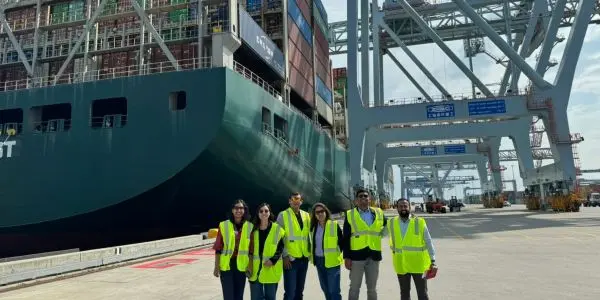By: Charvi Arora
Strong ports build strong economies. As global trade faces growing challenges, ports must evolve to become not only efficient but also smart and secure. Nikita Singla, a specialist in trade facilitation and logistics, explored these issues through the 2024 Quad Infrastructure Fellowship. Supported by the U.S. Department of State, the fellowship brings together professionals from the Indo-Pacific region, who work on resilient infrastructure.
Singla has worked at more than 40 ports in South Asia and currently serves as a non-resident scholar at the Carnegie Endowment for International Peace and a consultant to the World Bank . Her fellowship experience aligns with the February 2025 U.S.-India Joint Leaders’ Statement , in which President Donald Trump and Prime Minister Narendra Modi prioritized investing in critical infrastructure and economic corridors to promote regional peace and security.
During her visit to the United States, Singla saw firsthand how ports like Seattle and Boston leverage technology and strong governance to enhance trade and safety. Her experience highlights how U.S.-India cooperation can strengthen supply chains, deepen economic ties and build resilience in both countries.
Excerpts from an interview.
Can you share your key experiences during the Quad Infrastructure Fellowship and how your visit to the United States shaped your perspective on infrastructure projects?
This fellowship gave me an opportunity to engage with port experts across the Indo-Pacific region. We visited Seattle, Boston and Washington, D.C., and met key stakeholders including the U.S. Department of State , U.S. Customs and Border Protection , U.S. Coast Guard , Port of Seattle , Port of Boston, Massachusetts Institute of Technology and The Fletcher School at Tufts University .
The fellowship helped me explore new approaches to port security. What stood out the most was the emphasis on collaboration over competition. Engaging with professionals from different backgrounds fostered mutual learning and encouraged fresh thinking on developing future-ready port infrastructure.
What key skills from your fellowship will continue to shape your work in port development?
One key learning came from our session with the U.S. Customs and Border Protection, where we explored the Customs-Trade Partnership Against Terrorism (CTPAT) . It highlighted security standards, risk assessments and trusted trader systems. This helped me understand how such a framework connects with India’s AEO (Authorized Economic Operator) initiative. It also reinforced the importance of strong trade partnerships and U.S.-India collaboration.
Our meetings with the U.S. Department of State and the Department of Homeland Security underscored the critical role secure port infrastructure plays in supporting global trade and resilient supply chains. These exchanges deepened our understanding of our role in shaping the future of infrastructure in the Indo-Pacific region.
In your view, why is Quad cooperation strategically important for driving infrastructure development in the Indo-Pacific, especially for India and the United States?
Quad cooperation goes beyond a strategic alliance—it is built on shared values like transparency and respect for international rules.
For India, the Quad strengthens the country’s regional role and helps attract investment in future-ready infrastructure. It also supports India’s efforts to keep key trade routes—on land and at sea—secure and open, which is vital for a strong economy. For the United States, the Quad reinforces its commitment to a free and open Indo-Pacific. It also creates new business opportunities for American companies in emerging infrastructure markets.
Beyond geopolitics and market access, the Quad’s collaborative spirit—working together on shared challenges—is noteworthy. This shared sense of purpose makes the Quad powerful. It’s a platform for real and impactful change on the ground.
How does resilient port infrastructure help stabilize global supply chains and safeguard trade flows, particularly in the Indo-Pacific context?
Global supply chains face constant disruptions—from pandemics to geopolitical tensions. In this context, resilient port infrastructure is essential for keeping trade stable and secure.
For both India and the United States, building strong, future-ready ports supports not only trade, but also national security, economic independence and regional influence.
U.S.-India collaboration in this area has immense potential. From sharing knowledge to improving port governance and setting standards for secure trade corridors, both countries have much to offer each other. Resilient ports are more than just infrastructure; they are economic lifelines. When we build them the right way, we build trust into the global trade system.
What are the major challenges and opportunities in attracting long-term investment into port infrastructure within the Indo-Pacific region, and how can the Quad nations collaborate on this?
Port infrastructure today is about more than just moving cargo. It supports economic growth, secures trade routes and helps manage global disruptions. Both India and the United States recognize this, though they face different challenges.
In India, the priorities are modernizing aging ports, improving last-mile connectivity, and building resilient systems. U.S. ports, though more advanced, also often deal with aging infrastructure and labor shortages.
To keep supply chains running smoothly and securely, we need strong ports. This is where the U.S.-India partnership becomes crucial. Together, there is significant potential—from joint ventures and knowledge-sharing programs to building smart port models.
(This article is published as part of a special arrangement between Kashmir Images and SPAN Magazine, the publication of the U.S. Embassy in India (https://spanmag.state.gov/).











